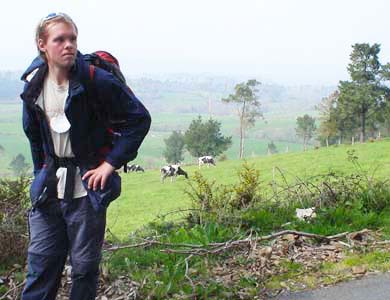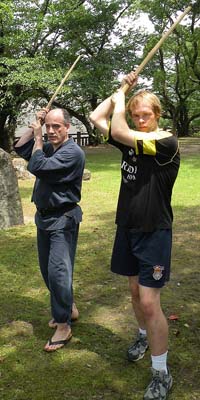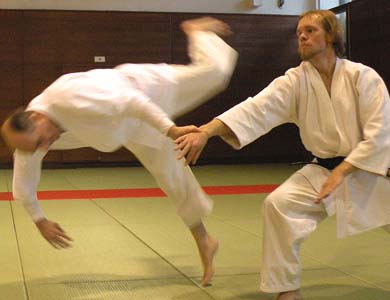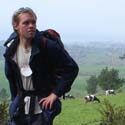
Nick Hoekstra takes in the mountain air along the Trail of Santiago. (Image courtesy of Nick Hoekstra.)
Nick Hoekstra, ’06, will talk to anyone. More precisely, he’ll listen to anyone.
Like those hikers he met while trekking the Trail of Santiago. Or his classmates at the Universidad Pontifícia in Chile. Even that woman on the train in Japan. First she told him his shoelace was untied, then she launched into a philosophical dissertation on education.
“For whatever reason I get into incredibly deep conversations with complete strangers,” Hoekstra says. “People are just really comfortable talking to me.”
The unimaginative observer would say it’s because people see Hoekstra—blind since the age of eight—as “safe.” But it takes just a few minutes of conversation to understand what’s really going on. “I love people,” Hoekstra says. “The way people live their lives is so fascinating to me. And the fact that people find me interesting is interesting in itself.”
The 27-year-old Hoekstra is a multilingual English teacher, avid hiker, and martial arts aficionado. Fluent in both Spanish and Japanese, he currently is studying to be a martial arts instructor and is considering a graduate degree in international education and policy. Enriched by an array of study-abroad experiences as a Michigan undergrad, Hoekstra hopes to help other students living with disabilities follow his lead.

Hoekstra has trained in Niten Ichi-Ryu, the two-sword style of kenjitsu developed by Miyamoto Musashi. (Photo courtesy of Nick Hoekstra.)
“The only way to change someone’s opinions about people with disabilities is to show them what’s possible,” Hoekstra says. “In all these places I’ve gone, I’ve been something of a pioneer, and I’ve enjoyed it so much that I really want to help others have the same opportunities.”
Plus, if he pursues a career in international studies, Hoekstra admits, he can continue his own global odyssey. Next, he’d like to immerse in ancient civilizations, exploring Latin American and Native American cultures. He’s also obsessed with India: “That’s one place I would flip out to see.”
Don’t fence me in
Though always headstrong and self-confident (thanks to supportive parents and friends), Hoekstra says it was the University of Michigan that gave him his first real taste of independence. He fed his passion for cross-cultural studies through the U-M Global Intercultural Experience for Undergraduates program. Initially he traveled to Santiago, where he interviewed Spanish-speaking pilgrims on behalf of the Romance Languages Department. The following year he traveled to Chile where he immersed in the university experience, living with a local family, participating in student groups, and hiking the Andes. Ultimately he graduated with a double major in Spanish and psychology and returned to Spain where he taught English through the Ministry of Education.
While there, Hoekstra experienced the Organizacio Nacional de Ciegos Espanol (the National Organization of Spanish Blind People). Flush with resources to support the visually impaired, it’s “the place to go if you’re blind,” Hoekstra says. “But at the same time, it’s the only place to go. I never like to be grouped: ‘You’re a member of the blind community, so go live with the blind community, go work with the blind community.’ Maybe I don’t want to live there. Maybe I want to work someplace else.”
Ironically, it’s the “someplace else” that brought Hoekstra back to the blind community after all. In the course of his travels, he began to identify some long-term goals.
“Ten years ago, I would have said I’ll do anything to avoid being associated with the blind community. Today, I’d like to encourage more people with disabilities to travel and study abroad. I don’t know how much of a difference I can make, but I’m going to do as much as I can.”
The martial artist
For Hoekstra that means setting an example by pursuing his passions. As a Michigan student he discovered an affinity for judo and aikido. Once he completed his post-graduate stint in Spain he landed a prestigious two-year assignment via the Japanese Exchange and Teaching Program. This brought him closer to the martial artists he so admired. He stayed in Japan for an extra year and enrolled in the International Budo University; he is the first foreigner with a disability the school has ever admitted. Majoring in judo, he worked alongside world-renowned senseis to hone his skills and customize a few stealth moves.

Hoekstra throws instructor Thierry Comont while studying martial arts at Japan’s International Budo University. (Image courtesy of Nick Hoekstra.)
“I’m so used to feeling the way people’s shoulders shift when I walk with them that I kind of know where their feet are being placed,” he says. “I’ve done some amazing foot sweeps on people that I have no business being able to throw around.”
For all his victories, however, Hoekstra encountered some daunting physical, logistical, and psychological challenges that he plans to share in a forthcoming how-to guide for travelers with disabilities.
“In some ways it can be very comical to travel as a person with disabilities,” he says. “It also can be very sad.”
During his eight months in Chile, for example, Hoekstra plunged into a deep depression after repeatedly bumping up against cultural and emotional barriers. He wrote about the experience in a class on monsters in Latin American literature.
“Sometimes I felt like I was a monster because I was treated with such condescension,” he says. “I simply didn’t know how to cope with that.”
In Japan he came up against a different set of obstacles, fighting to assert his independence. “I was breaking so many rules just by being there—I was stepping outside their comfort zone,” he notes.
The iron goat
Back in his stomping grounds of Grand Rapids, Mich., Hoekstra is busy planning his next adventure. In addition to exploring a career in academia with a focus on study abroad, he’s training for a solo hike of the entire Trail of Santiago, about 700 kilometers from start to finish. It’s a mental exercise more than a physical one, as the experience will force him to approach strangers to ask if he can tag along for a stretch.
“This will do two things,” Hoekstra says. “One, it will expose a lot of people to the fact that a blind guy can hike. Two, it will put me in a situation I’m very uncomfortable with. I do not like to depend on people. and this will put me in a situation where I have to depend on people.”
Talk to Hoekstra about hiking and before long you have a visceral sense of the long, slow burn that comes with a long, slow climb. He describes the intense flavor of a meal at the end of full day, the sound of his clomping boots, and the subtle changes he experiences on ascent.
“Once we were coming up this mountain in Galicia [in northwest Spain]—it was a rigorous climb and we were really sweating,” he recalls. “When we got to the top it was totally covered in fog. It was like stepping into a cloud—this cool condensation all over your skin. It felt so awesome.”
He records observations like these in his blog, aptly titled Tales of the Iron Goat. The nickname, “a conspiracy of several friends,” combines his two favorite activities. “In the martial arts, you have all these people who are called the ‘Iron Monkey’ or ‘the Iron Fist,'” he says. “One of my friends compared me to a goat one time—supposedly based on my long face and my style of hiking—and that was it. Now I just need to get bitten by a radioactive goat so I can eat plastic bottles and shimmy up more mountains.”
Friend and mentor Janet Afonso has her own nickname for Hoekstra. “I call him ‘The Amazing Nico,'” says the international program coordinator at the Center for Global Opportunities in Kinesiology. “By any definition, the array of international experiences Nick acquired while a U-M student and since graduation is extraordinary. Soon after meeting him, I realized how irrelevant his blindness was to him, and to his ability to achieve his goals. I have never met a sighted person with clearer vision, and I am grateful for the many ways in which he taught me to see for the first time.”




Chakila Hoskins - BFA in Painting 2012
This is a wonderful article about Nick Hoekstra and his life experiences. He is truly an amazing and inspiring individual. I had the pleasure to meet Nick Hoekstra in September 2012 during ArtPrize in Grand Rapids, MI. I am an artist that believes that art should be experienced and accessible to all people, including the visually impaired community. I had an exhibit titled “Resurrection: A Spiritual Journey” created to include the visually impaired, therefore “touch” was involved. It was in the chapel of First Park Congregational Church. Nick and his parents were able to experience the exhibition. I was so touched to hear his story and to watch him engage with my artwork.
I have been wanting to contact him but all I have is his BlogSpots.
He is truly a living testimony and I pray that he continues his hope to help other students with disabilities to be encouraged and live there lives in happiness and achieve goals that may seem impossible.
Chakila L. Hoskins
Reply